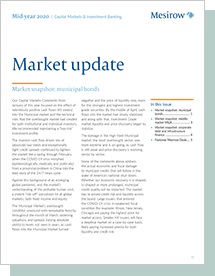Insights
Mid-year update
Share this article
Market snapshot: municipal bonds
Our Capital Markets Comments from January of this year focused on the effect of relentlessly positive cash flows (45 weeks) into the Municipal market and the technical risks that the overbought market had created for both institutional and individual investors. We recommended maintaining a “low risk” investment profile.
The investor cash flow driven mix of (absolute) low yields and exceptionally tight credit spreads continued to tighten the market like a spring through February, when the COVID-19 virus morphed (epidemiologically, medically and politically) from a provincial problem in China into the lead story of the 24/7 news cycle.
Against this background of an emerging global pandemic, and the market’s understanding of the probable human cost, a violent “risk-off” convulsion hit all global markets; both fixed income and equity.
The Municipal Market’s overbought condition unwound with remarkable ferocity throughout the month of March, widening valuations and spreads (raising absolute yields) to levels not seen in years, as cash flows into the Municipal Market turned negative and the price of liquidity rose, even for the strongest and highest Investment grade securities. By the middle of April, cash flows into the market had slowly stabilized, and along with that, Investment Grade market liquidity and price discovery began to stabilize.
The damage in the High Yield Municipal market, the most overbought sector, was more extreme and is on-going, as cash flow is still weak and price discovery is evolving, sector by sector.
None of the comments above address the actual economic and fiscal damage to municipal credits that will follow in the wake of America’s national shut-down. Whether our economic recovery is V-shaped, U-shaped or more prolonged, municipal credit quality will be impacted. The market has re-priced credit risk and liquidity across the board. Large issuers that entered the COVID-19 crisis in weakened fiscal condition (for example; Illinois, New Jersey, Chicago) are paying the highest price for market access. Smaller HY issuers will face a skeptical market on a case-by-case basis, likely paying increased premia for both liquidity and credit risk.

Spark
Our quarterly email featuring insights on markets, sectors and investing in what matters
